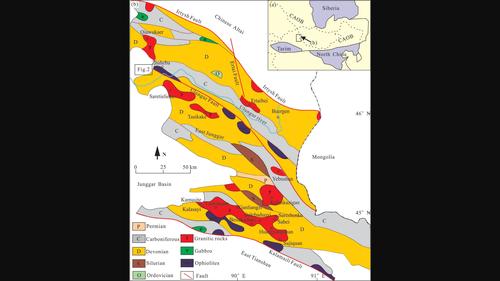当前位置:
X-MOL 学术
›
Acta Geol. Sinica Engl. Ed.
›
论文详情
Our official English website, www.x-mol.net, welcomes your
feedback! (Note: you will need to create a separate account there.)
Petrogenesis and Tectonic Implications of A-type Granites in Zhaheba in the East Junggar Region of Xinjiang, China: Evidence from Geochronology, Geochemistry and Sr-Nd Isotopic Compositions
Acta Geologica Sinica-English Edition ( IF 3.5 ) Pub Date : 2021-08-22 , DOI: 10.1111/1755-6724.14802 Hejun TANG 1, 2 , Guixiang MENG 1, 2 , Zhenhan WU 1, 2 , Zhaolin WANG 1, 2 , Zhen DENG 1, 2 , Jiayong YAN 1, 2 , Guang QI 1, 2 , Ronghui XUE 1, 2
Acta Geologica Sinica-English Edition ( IF 3.5 ) Pub Date : 2021-08-22 , DOI: 10.1111/1755-6724.14802 Hejun TANG 1, 2 , Guixiang MENG 1, 2 , Zhenhan WU 1, 2 , Zhaolin WANG 1, 2 , Zhen DENG 1, 2 , Jiayong YAN 1, 2 , Guang QI 1, 2 , Ronghui XUE 1, 2
Affiliation

|
The magma source, petrogenesis, tectonic setting and geochronology of the late Paleozoic A-type granites widely exposed in the Zhaheba area, East Junggar, have thus far not been well-constrained. A better understanding of these issues will help to reveal the magmatic processes and continental growth of Central Asia. The A-type granites in Zhaheba include the Ashutasi alkaline granites and the Yuyitasi syenogranites, which were emplaced at 321.5 ± 4.8 Ma and 321.7 ± 0.6 Ma, respectively. The major rock-forming minerals are orthoclase, perthite, arfvedsonite and quartz, which exhibit the following principal geochemical characteristics of A2-type granites. (1) Their REE distribution curves each exhibit a ‘V‘-shaped pattern and a marked depletion in Eu. They are rich in large-ion lithophile elements Rb, Th and U as well as high-field-strength elements Nb, Ta, Zr and Hf, but significantly depleted in Ba, Sr, P and Ti. (2) Their (87Sr/86Sr)i values (0.7021–0.7041), εNd(t) values (4.57–5.16) and REE distribution patterns are in basic agreement with those of the Kalamaili A-type granite belt in East Junggar. The TDM2 values of the alkaline granites and syenogranites range from 661 to 709 Ma. The A-type granites may be the products of upwelling asthenosphere-triggered partial melting of immature lower crust. The alkaline granites were late-stage products of crystallization and differentiation. Compared to the syenogranites, the alkaline granites are significantly lower in K2O, Na2O, Al2O3, FeO, MgO and CaO, but significantly higher in incompatible elements (e.g., SiO2, Rb, and Sr). The magmatic crystallization temperatures of the syenogranites and alkaline granites are 874°C and 819°C, respectively. As their age gradually decreases (peak ages: 322 Ma and 307 Ma, respectively), there is a gradual decrease in the TDM2 of the A-type granites and a gradual increase in the εNd(t) value from the Ulungur belt to the Kalamaili belt in East Junggar. The study of A-type granites is therefore one of the keys to understanding the laws and mechanisms of crustal accretion during the Phanerozoic period, as well as also being of great significance for understanding the Paleozoic accretion.
更新日期:2021-08-22









































 京公网安备 11010802027423号
京公网安备 11010802027423号